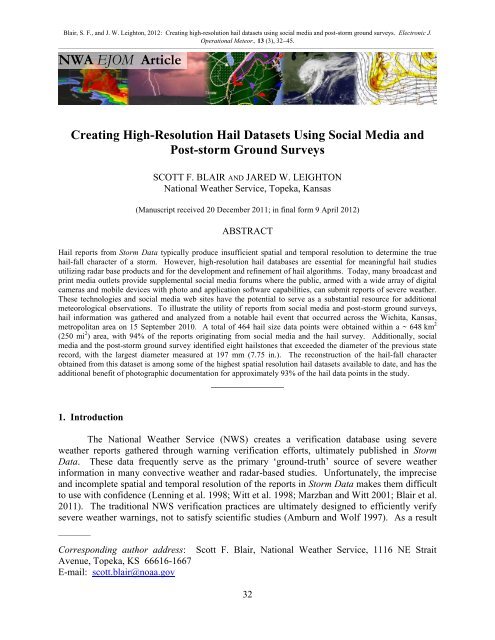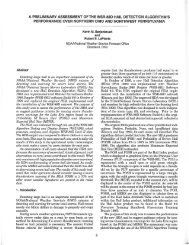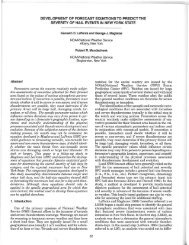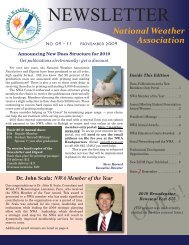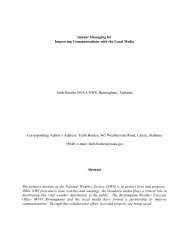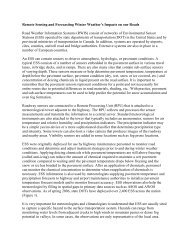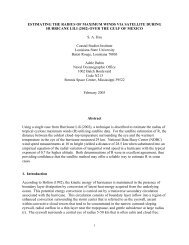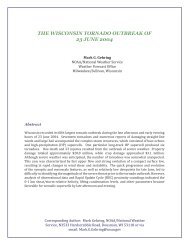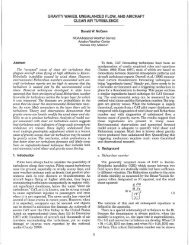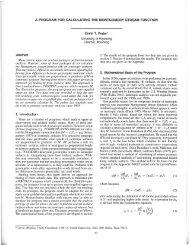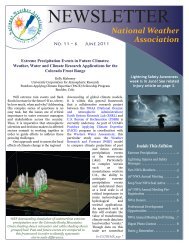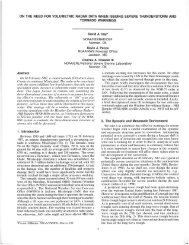Creating high-resolution hail datasets using social media and post ...
Creating high-resolution hail datasets using social media and post ...
Creating high-resolution hail datasets using social media and post ...
You also want an ePaper? Increase the reach of your titles
YUMPU automatically turns print PDFs into web optimized ePapers that Google loves.
Blair, S. F., <strong>and</strong> J. W. Leighton, 2012: <strong>Creating</strong> <strong>high</strong>-<strong>resolution</strong> <strong>hail</strong> <strong>datasets</strong> <strong>using</strong> <strong>social</strong> <strong>media</strong> <strong>and</strong> <strong>post</strong>-storm ground surveys. Electronic J.<br />
Operational Meteor., 13 (3), 3245.<br />
––––––––––––––––––––––––––––––––––––––––––––––––––––––––––––––––––––––––––––––––––––––––––––––––––––––––––––––––––––<br />
NWA EJOM Article<br />
<strong>Creating</strong> High-Resolution Hail Datasets Using Social Media <strong>and</strong><br />
Post-storm Ground Surveys<br />
SCOTT F. BLAIR AND JARED W. LEIGHTON<br />
National Weather Service, Topeka, Kansas<br />
(Manuscript received 20 December 2011; in final form 9 April 2012)<br />
ABSTRACT<br />
Hail reports from Storm Data typically produce insufficient spatial <strong>and</strong> temporal <strong>resolution</strong> to determine the true<br />
<strong>hail</strong>-fall character of a storm. However, <strong>high</strong>-<strong>resolution</strong> <strong>hail</strong> databases are essential for meaningful <strong>hail</strong> studies<br />
utilizing radar base products <strong>and</strong> for the development <strong>and</strong> refinement of <strong>hail</strong> algorithms. Today, many broadcast <strong>and</strong><br />
print <strong>media</strong> outlets provide supplemental <strong>social</strong> <strong>media</strong> forums where the public, armed with a wide array of digital<br />
cameras <strong>and</strong> mobile devices with photo <strong>and</strong> application software capabilities, can submit reports of severe weather.<br />
These technologies <strong>and</strong> <strong>social</strong> <strong>media</strong> web sites have the potential to serve as a substantial resource for additional<br />
meteorological observations. To illustrate the utility of reports from <strong>social</strong> <strong>media</strong> <strong>and</strong> <strong>post</strong>-storm ground surveys,<br />
<strong>hail</strong> information was gathered <strong>and</strong> analyzed from a notable <strong>hail</strong> event that occurred across the Wichita, Kansas,<br />
metropolitan area on 15 September 2010. A total of 464 <strong>hail</strong> size data points were obtained within a ~ 648 km 2<br />
(250 mi 2 ) area, with 94% of the reports originating from <strong>social</strong> <strong>media</strong> <strong>and</strong> the <strong>hail</strong> survey. Additionally, <strong>social</strong><br />
<strong>media</strong> <strong>and</strong> the <strong>post</strong>-storm ground survey identified eight <strong>hail</strong>stones that exceeded the diameter of the previous state<br />
record, with the largest diameter measured at 197 mm (7.75 in.). The reconstruction of the <strong>hail</strong>-fall character<br />
obtained from this dataset is among some of the <strong>high</strong>est spatial <strong>resolution</strong> <strong>hail</strong> <strong>datasets</strong> available to date, <strong>and</strong> has the<br />
additional benefit of photographic documentation for approximately 93% of the <strong>hail</strong> data points in the study.<br />
_______________<br />
1. Introduction<br />
The National Weather Service (NWS) creates a verification database <strong>using</strong> severe<br />
weather reports gathered through warning verification efforts, ultimately published in Storm<br />
Data. These data frequently serve as the primary ‘ground-truth’ source of severe weather<br />
information in many convective weather <strong>and</strong> radar-based studies. Unfortunately, the imprecise<br />
<strong>and</strong> incomplete spatial <strong>and</strong> temporal <strong>resolution</strong> of the reports in Storm Data makes them difficult<br />
to use with confidence (Lenning et al. 1998; Witt et al. 1998; Marzban <strong>and</strong> Witt 2001; Blair et al.<br />
2011). The traditional NWS verification practices are ultimately designed to efficiently verify<br />
severe weather warnings, not to satisfy scientific studies (Amburn <strong>and</strong> Wolf 1997). As a result<br />
__________<br />
Corresponding author address:<br />
Avenue, Topeka, KS 66616-1667<br />
E-mail: scott.blair@noaa.gov<br />
Scott F. Blair, National Weather Service, 1116 NE Strait<br />
32
of the inherent low-<strong>resolution</strong> nature of Storm Data, there is a need for methods that improve the<br />
<strong>resolution</strong> in the severe weather database, especially for radar-based studies attempting to derive<br />
unique signatures from <strong>hail</strong> reports.<br />
High-<strong>resolution</strong> <strong>hail</strong> databases are essential for meaningful <strong>hail</strong> research utilizing<br />
Weather Surveillance Radar-1988 Doppler (WSR-88D; Crum <strong>and</strong> Alberty 1993) legacy <strong>and</strong><br />
dual-polarization base products, <strong>and</strong> for the development <strong>and</strong> refinement of <strong>hail</strong> algorithms. The<br />
representation of the <strong>hail</strong>-fall character of a storm increases with <strong>high</strong>-<strong>resolution</strong> <strong>hail</strong> databases.<br />
Studies utilizing these <strong>high</strong>er <strong>resolution</strong> reports are subject to minimal error compared to those<br />
only incorporating reports from Storm Data (Fig. 1). Currently, the only <strong>high</strong>-<strong>resolution</strong> <strong>hail</strong><br />
<strong>datasets</strong> that adequately identify the <strong>hail</strong>-fall character in storms originate from the Severe<br />
Hazards Analysis <strong>and</strong> Verification Experiment (SHAVE; Ortega et al. 2009) <strong>and</strong> A Hail Spatial<br />
<strong>and</strong> Temporal Observing Network Effort (HailSTONE; http://<strong>hail</strong>stoneresearch.org/). While<br />
these efforts produce a wealth of information <strong>and</strong> insight into the character of <strong>hail</strong> storms, they<br />
unfortunately operate on a limited basis <strong>and</strong> over a limited domain area.<br />
Figure 1. (a) An example of the spatial distribution of <strong>hail</strong> reports comparing <strong>high</strong>-<strong>resolution</strong><br />
(HailSTONE, green triangle) versus low-<strong>resolution</strong> (Storm Data, red circle) <strong>hail</strong> <strong>datasets</strong><br />
collected from 2000 UTC to 2030 UTC on 24 May 2011. (b) WSR-88D Oklahoma City<br />
(KTLX) 0.5 o base reflectivity image from 24 May 2011 at 2006 UTC used for reference.<br />
In today’s society, the public is armed with a wide array of mobile devices with photo<br />
<strong>and</strong> video capabilities that can easily share imagery on the Internet. Some of these technologies<br />
incorporate geotagging, which allows for location-specific information to be included within the<br />
imagery. Many <strong>media</strong> outlets encourage users to submit weather photos to their respective <strong>social</strong><br />
<strong>media</strong> forums during weather events, resulting in an abundance of public weather-related<br />
information. In many cases, without this collection of <strong>social</strong> <strong>media</strong> information, the<br />
meteorological community would have insufficiently documented severe weather events <strong>and</strong><br />
other weather phenomena (Hyvärinen <strong>and</strong> Saltikoff 2010). While the initial intentions of <strong>social</strong><br />
<strong>media</strong> weather information are generally not aimed at scientific research, these observations in a<br />
quality-controlled environment have the potential to serve as a substantial resource in severe<br />
storm verification. This paper illustrates the utility of <strong>social</strong> <strong>media</strong> reports <strong>and</strong> additional<br />
33
verification efforts as resources in creating a <strong>high</strong>-<strong>resolution</strong> <strong>hail</strong> dataset from a notable <strong>hail</strong><br />
event that occurred across the Wichita, Kansas, metropolitan area on 15 September 2010.<br />
2. Hail data <strong>and</strong> methodology<br />
a. Case example: 15 September 2010<br />
On 15 September 2010, deep convection initiated over Reno County, Kansas, at<br />
approximately 2030 UTC. One long-lived supercell moved southeastward through portions of<br />
south-central Kansas over a 5-h period, impacting thous<strong>and</strong>s of residents, including a large<br />
portion of the Wichita metropolitan area (Fig. 2). Most notably, the supercell produced an<br />
expansive swath of significant <strong>hail</strong> (diameter ≥ 51 mm; ≥ 2.00 in.) across both urban <strong>and</strong> rural<br />
areas. Additionally, the storm produced five EF-0 tornadoes in Sedgwick <strong>and</strong> Cowley Counties.<br />
Figure 2. A time series composite of 0.5 o base reflectivity from the Wichita, Kansas (KICT),<br />
WSR-88D from 2112 UTC 15 September 2010 to 0030 UTC 16 September 2010.<br />
Residents identified a giant <strong>hail</strong>stone (hereafter referred to as the “Wichita stone”) in the<br />
western suburbs of Wichita that had a maximum diameter of 197 mm (7.75 in.). The State<br />
Climate Extremes Committee (SCEC) certified the Wichita stone as the new state record<br />
diameter <strong>hail</strong>stone, exceeding the previous record of 144 mm (5.67 in.) that occurred in<br />
Coffeyville, Kansas, on 3 September 1970 (Fig. 3). The individuals who retrieved the Wichita<br />
stone took diameter measurements within 30 minutes of occurrence. In diameter, the Wichita<br />
stone ranks as the second largest verifiable United States <strong>hail</strong>stone to date. Table 1 lists the<br />
“Top 5” verifiable <strong>hail</strong> stones, derived from <strong>hail</strong> reports with valid photographic evidence or<br />
34
confirmed through a review process of the SCEC. An initial assessment from the <strong>hail</strong> event in<br />
Sedgwick County estimates $150 million in damages, with more than 35,000 claims turned in to<br />
insurance agencies (NCDC 2010).<br />
Table 1. The “Top 5” largest verifiable <strong>hail</strong> stones by diameter in the United States. The rank,<br />
event location <strong>and</strong> date, maximum diameter <strong>and</strong> circumference, <strong>and</strong> a photo of the <strong>hail</strong>stone are<br />
listed below for each entry. An asterisk denotes measurements made after nontrivial melting<br />
occurred.<br />
35
Figure 3. The (a) Wichita, Kansas, <strong>hail</strong>stone from 15 September 2010 with a maximum<br />
diameter of 197 mm (7.75 in.) compared to the (b) Coffeyville, Kansas, <strong>hail</strong>stone from 3<br />
September 1970 with a maximum diameter of 144 mm (5.67 in.).<br />
The data collected from the 15 September 2010 case incorporated all known available<br />
sources that contained <strong>hail</strong> information within the study domain, a 648 km 2 (250 mi 2 ) area<br />
centered over western Wichita, Kansas, that included the surrounding communities of Andale,<br />
Derby, Garden Plain, <strong>and</strong> Goddard. Hail data originated from three main sources: a) NWS local<br />
storm reports (LSRs), b) a <strong>post</strong>-storm ground survey, <strong>and</strong> c) several <strong>social</strong> <strong>media</strong> related web<br />
sites. The <strong>hail</strong> data were compiled in an Excel spreadsheet <strong>and</strong> imported into the Environmental<br />
Systems Research Institute’s (ESRI) ArcMap by adding the latitude <strong>and</strong> longitude columns as x–<br />
y data. These data were then graphically depicted through an inverse distance weighted<br />
interpolation. The geographic information system (GIS) based maps of all <strong>hail</strong> reports collected<br />
provided tremendous insight into the <strong>hail</strong>-fall character of the storm.<br />
b. NWS <strong>hail</strong> reports<br />
To begin the construction of the <strong>hail</strong> database, NWS LSRs from 15 September 2010 were<br />
compiled. LSRs were utilized in place of Storm Data due to the <strong>high</strong>er number of available <strong>hail</strong><br />
size data points. With this particular event, a single data entry in Storm Data incorporated many<br />
of the <strong>hail</strong> LSRs, providing only a start <strong>and</strong> end location of a singular swath of maximum <strong>hail</strong><br />
size. Specific <strong>hail</strong> size information from the report location, including an improved temporal<br />
<strong>resolution</strong>, was available from the LSRs, making them the most attractive option in this case.<br />
Information that was collected from LSRs included the report time, measured or estimated<br />
maximum diameter <strong>hail</strong> size, <strong>and</strong> the location of the report.<br />
c. Post-storm ground survey<br />
A <strong>post</strong>-storm ground survey was conducted on 16 September 2010 after the NWS in<br />
Wichita, Kansas (NWS ICT) received several reports of giant <strong>hail</strong> (diameter ≥ 102 mm; ≥ 4.00 in.),<br />
36
including the Wichita stone. The objectives of the survey were to (1) assist NWS ICT with official<br />
measurements of the Wichita stone, (2) potentially identify any <strong>hail</strong> sizes larger than the Wichita<br />
stone, <strong>and</strong> (3) acquire additional <strong>hail</strong> reports within <strong>and</strong> in close proximity to the areas impacted by<br />
the largest <strong>hail</strong> in order to improve the report <strong>resolution</strong> for a separate radar-based study (Blair et<br />
al. 2011). A 24-km (15-mi.) long path of both rural <strong>and</strong> urban areas was surveyed from Garden<br />
Plain to the Wichita Mid-Continent Airport, including several subdivisions on the western side of<br />
Wichita. In the event that residents preserved <strong>hail</strong> in their freezers, the authors measured <strong>and</strong><br />
recorded the diameter, circumference, <strong>and</strong> weight of each stone (Fig. 4). The authors also inquired<br />
whether residents made any <strong>hail</strong> reports to local authorities, <strong>media</strong>, or the NWS. Photographs were<br />
taken of each <strong>hail</strong>stone measured <strong>and</strong> the location was recorded.<br />
Figure 4. An example of <strong>hail</strong>stones identified during the <strong>post</strong>-storm ground survey that were<br />
preserved by residents in the Wichita, Kansas, metropolitan area.<br />
d. Social <strong>media</strong><br />
To supplement the reports obtained by the <strong>post</strong>-storm survey <strong>and</strong> NWS LSRs, <strong>hail</strong><br />
information was gathered from eight different web-based <strong>social</strong> <strong>media</strong> outlets (Table 2). These<br />
web-based sources included local <strong>and</strong> national television stations, local print <strong>media</strong>, <strong>and</strong><br />
dedicated <strong>social</strong> <strong>media</strong> sites that allowed video- <strong>and</strong> photo-sharing capabilities. In the context of<br />
this paper, <strong>social</strong> <strong>media</strong> are defined as interactive forums through which users could upload<br />
photos or video, share details, <strong>and</strong> view <strong>and</strong> comment on other’s experiences from a particular<br />
event. The information contained within these <strong>social</strong> <strong>media</strong> pages provided the framework to<br />
document <strong>and</strong> record <strong>high</strong> spatial <strong>resolution</strong> <strong>hail</strong> information. The maximum diameter <strong>hail</strong> size<br />
was derived from each photo <strong>and</strong> video, <strong>using</strong> a 6.4-mm (0.25 in.) <strong>resolution</strong>. The majority of<br />
user-provided images compared the <strong>hail</strong>stone next to commonly-sized objects, tape measures, or<br />
rulers. For imagery that included no st<strong>and</strong>ard size comparison but included less traditional<br />
objects such as household or outdoor items, an estimated size was recorded. In the event that the<br />
<strong>hail</strong>stone was shown with no discernable object for size comparison, the report was removed<br />
37
from the database. Some inherent subjectivity was necessary for classifying specific maximum<br />
diameter <strong>hail</strong> sizes from amateur photos <strong>and</strong> videos, <strong>and</strong> additional uncertainty during the <strong>hail</strong><br />
size classification stemmed from potential parallax errors. The size of the parallax error<br />
depended on the height <strong>and</strong> location of the <strong>hail</strong>stone relative to the camera lens. Individual cases<br />
were removed from the database when an approximate <strong>hail</strong> size could not be resolved due to<br />
considerable parallax errors. While the aforementioned methods of determining the maximum<br />
<strong>hail</strong> stone diameter allowed some uncertainty in the database with respect to the approximated<br />
diameters, the authors contend the data quality as a whole is likely superior to telephone-based<br />
reports of estimated <strong>hail</strong> sizes from the public due to the availability of photographic evidence<br />
<strong>and</strong> a consistent method for each case.<br />
Table 2. Social <strong>media</strong> sources incorporated in the study that contained specific <strong>hail</strong> information<br />
from 15 September 2010.<br />
1) BROADCAST MEDIA, PRINT MEDIA, FACEBOOK, AND TWITTER<br />
Interactive photo galleries supplemented traditional broadcast <strong>and</strong> print <strong>media</strong> web pages<br />
in the Wichita metropolitan area. In these galleries, users were able to upload one or more<br />
photos of the event with the option to include a brief narrative caption (Fig. 5). There was also a<br />
section where individuals could leave comments about the images <strong>post</strong>ed. Facebook <strong>and</strong> Twitter<br />
pages had a similar design of information-sharing. The authors searched for <strong>hail</strong> photos on the<br />
NWS Wichita Skywarn Facebook page, <strong>and</strong> on Twitter <strong>using</strong> the “hashtag” designation<br />
“#ksstorms.” Each available photo was preserved, <strong>and</strong> data derived from the photos <strong>and</strong><br />
narratives were recorded <strong>and</strong> entered into the database.<br />
Photo captions frequently identified the location of the photographer, either by listing the<br />
intersection of two roadways or explicitly defining the address. In other cases it appeared that<br />
the photographers periodically approximated the location of the photograph <strong>using</strong> recognizable<br />
roadway intersections or l<strong>and</strong>marks closest to their respective location. Google Earth was<br />
utilized to locate the latitude <strong>and</strong> longitude coordinates of the specified <strong>hail</strong> location in the photo<br />
38
caption, <strong>and</strong> this information was quality controlled to determine if the provided location was<br />
reasonably accurate. In cases where no caption was listed or the address was unclear, the user’s<br />
photo was removed from the database.<br />
Figure 5. An example of <strong>hail</strong> photos uploaded by users on the KAKE <strong>social</strong> <strong>media</strong> photo forum<br />
from 15 September 2010.<br />
39
2) YOUTUBE<br />
The video sharing website YouTube (http://www.youtube.com) was interrogated for<br />
videos related to the 15 September 2010 <strong>hail</strong> storm. An initial search for “giant <strong>hail</strong> Wichita”<br />
was performed to identify videos taken <strong>and</strong> uploaded by residents <strong>and</strong> storm chasers, <strong>and</strong> videos<br />
of this event resulting from the search were then examined until all original videos were<br />
exhausted. Each YouTube account holder that uploaded a video from the <strong>hail</strong> storm was<br />
contacted with a request to provide the approximate time of the <strong>hail</strong>, the location where the video<br />
was taken, <strong>and</strong> the largest diameter of the <strong>hail</strong> in the video. The resulting information from this<br />
correspondence was utilized in the database.<br />
3. Results <strong>and</strong> discussion<br />
a. Reports, survey, <strong>and</strong> <strong>social</strong> <strong>media</strong><br />
1) NWS HAIL REPORTS<br />
NWS LSRs accounted for 30 <strong>hail</strong> reports within the study domain. However, several of<br />
the report locations contained multiple reports of varying <strong>hail</strong> sizes as either stones became<br />
larger at a given area with time, or geographical-coordinated estimates placed reports in similar<br />
locations. Therefore, only 13 unique locations containing a maximum diameter <strong>hail</strong> size were<br />
produced from the LSRs.<br />
2) POST-STORM GROUND SURVEY<br />
The NWS <strong>post</strong>-storm ground survey established contact with 60 residents across the<br />
western sections of the Wichita metropolitan area. Approximately 80% of the surveyed residents<br />
preserved <strong>hail</strong>stones in their freezers. While some individuals placed <strong>hail</strong> in sealed plastic bags,<br />
the majority left stones exposed to the effects of sublimation. The residents indicated that the<br />
primary motivating factor of keeping the <strong>hail</strong>stones was for insurance purposes. Some<br />
individuals that preserved the stones also indicated that they did not collect the largest <strong>hail</strong> they<br />
observed. All stones saved by the residents had diameters ≥ 64 mm (≥ 2.50 in.), with a <strong>media</strong>n<br />
size of 102 mm (4.00 in.). The <strong>high</strong> number of individuals found from the survey that saved<br />
<strong>hail</strong>stones yields some promise for future <strong>post</strong>-storm verification efforts in which residents may<br />
be able to provide accurate measurements of <strong>hail</strong> if explicitly prompted to do so.<br />
Significant property damage was observed over the surveyed areas. The most impressive<br />
damage from <strong>hail</strong> impacts consisted of punctured automobile windows, large impact craters on<br />
the ground, <strong>and</strong> plywood roofs <strong>and</strong> wooden decks penetrated by giant <strong>hail</strong>.<br />
A substantial find from the ground assessment was that no surveyed individuals contacted<br />
the NWS to report <strong>hail</strong> information, while approximately 2% reported a <strong>hail</strong> size to local<br />
authorities <strong>and</strong> 5% made reports to the <strong>media</strong> by phone or <strong>social</strong> <strong>media</strong>. These values illustrate<br />
the challenge of receiving real-time <strong>hail</strong> reports that provide an accurate assessment of the<br />
maximum <strong>hail</strong> size occurring in a storm, even in situations when <strong>high</strong>ly urban l<strong>and</strong>scapes are<br />
affected by significant <strong>hail</strong>. While the 5% of individuals reporting <strong>hail</strong> sizes to the <strong>media</strong><br />
appears to be a low percentage, it emphasizes the contributing role that <strong>social</strong> <strong>media</strong> could play<br />
40
in providing additional verification information that would otherwise not be reported to a local<br />
NWS office.<br />
3) SOCIAL MEDIA<br />
Web-based <strong>social</strong> <strong>media</strong> sources accounted for 387 <strong>hail</strong> reports. Approximately 90% of<br />
the <strong>social</strong> <strong>media</strong>-based <strong>hail</strong> photos with a narrative caption originated from the three Wichita<br />
television broadcast station web pages. A <strong>hail</strong> size distribution of the <strong>social</strong> <strong>media</strong> reports<br />
revealed some insight into the reporting behavior of local residents (Fig. 6). The size distribution<br />
of <strong>hail</strong> reports obtained from photographic evidence deviates from traditional NWS verification<br />
practices that tend to bias <strong>hail</strong> sizes to commonly-sized objects or coins (Jewell <strong>and</strong> Brimelow<br />
2009). The data also allow for some speculation that residents uploaded <strong>hail</strong> photos they felt<br />
were noteworthy to share, perhaps the largest <strong>hail</strong>stone within their proximity. It is interesting to<br />
note that only 3% of the uploaded photos contained <strong>hail</strong> smaller than the size of golf balls<br />
(44.5 mm; 1.75 in.) even though it is suspected that many urban locations, especially in the<br />
northeastern portion of the Wichita metropolitan area, received <strong>hail</strong> of this size. It is unknown<br />
whether the lack of reporting smaller <strong>hail</strong> sizes was a function of 1) a regional bias where large<br />
<strong>hail</strong> occurs more frequently <strong>and</strong> therefore smaller <strong>hail</strong> seems less notable, 2) a storm-specific<br />
bias where the coverage of significant <strong>hail</strong> in this storm was substantial <strong>and</strong> widespread, or 3) a<br />
seasonal bias where small <strong>hail</strong> during the convective season appears commonplace. More cases<br />
where <strong>social</strong> <strong>media</strong> plays a prominent role in <strong>hail</strong> verification will be required to assess the<br />
public’s reporting behavior of <strong>hail</strong> sizes, <strong>and</strong> their perception of what constitutes a ‘severe-sized’<br />
<strong>hail</strong>stone.<br />
Figure 6. Normalized (%) <strong>hail</strong> size distribution (in.) of <strong>social</strong> <strong>media</strong> reports from 15 September<br />
2010.<br />
41
. Recreating the <strong>hail</strong>-fall character<br />
A total of 464 <strong>hail</strong> data points were collected from all available sources <strong>and</strong> incorporated<br />
into the database (Fig. 7). Social <strong>media</strong> information accounted for 83% of the reports, while<br />
10% of the data points originated from the <strong>post</strong>-storm ground survey, <strong>and</strong> 7% of the points were<br />
from NWS LSRs. Approximately 93% of all the <strong>hail</strong> data points had accompanying photos of<br />
the maximum diameter <strong>hail</strong>stones. Hail reports with photographic documentation are superior to<br />
traditional reports, as the imagery helps mitigate uncertainty in the quality <strong>and</strong> validity of each<br />
<strong>hail</strong> data point. The tremendous number of available <strong>hail</strong> data points allowed for a <strong>high</strong> spatial<br />
<strong>resolution</strong> graphical reconstruction of the <strong>hail</strong>-fall character of the storm through time (Fig. 8).<br />
While an analysis of the <strong>hail</strong>-fall relative to radar-based signatures is beyond the scope of the<br />
paper, Figure 8 shows a decrease in the maximum <strong>hail</strong> size over time as the storm moved across<br />
the study domain, which would not have been apparent <strong>using</strong> only LSRs or Storm Data. This<br />
<strong>resolution</strong> of information is critical to accurately gauge <strong>hail</strong>-fall behavior <strong>and</strong> to help<br />
discriminate sensitive storm-scale changes that may be observed operationally by warning<br />
forecasters.<br />
Figure 7. Locations of 464 <strong>hail</strong> data points from NWS LSRs (green dots), the <strong>post</strong>-storm <strong>hail</strong><br />
survey (red dots), <strong>and</strong> <strong>social</strong> <strong>media</strong> (blue dots) utilized in the study. Urban areas (yellow) of the<br />
Wichita, Kansas, metropolitan area, primary Interstates (red lines), <strong>and</strong> state <strong>high</strong>ways (blue<br />
lines) are shown for reference.<br />
42
Eight <strong>hail</strong> stones, identified from the NWS <strong>post</strong>-storm ground survey <strong>and</strong> the search<br />
through <strong>social</strong> <strong>media</strong>-based web pages, exceeded the previous Kansas record diameter stone of<br />
144 mm (5.67 in.). The residents that discovered the Wichita stone uploaded an image of the<br />
stone to one of the local television station’s <strong>social</strong> <strong>media</strong>-based photo forums, <strong>and</strong> the station<br />
promptly shared the information with the NWS ICT during the ongoing severe weather event. It<br />
is worthy to note how important of a role such technologies served to document <strong>hail</strong>stones of this<br />
magnitude. While giant <strong>hail</strong> is a relatively rare phenomenon based on records in Storm Data, it<br />
has likely been underreported in the past (Blair et al. 2011). Table 1 reveals that the seven<br />
largest verifiable United States <strong>hail</strong>stones have occurred since 2003. Thus, it is reasonable to<br />
conclude more <strong>high</strong>-end <strong>hail</strong> events will continue to be documented as photo-sharing<br />
technologies become more widespread <strong>and</strong> utilized by the public <strong>and</strong> the meteorological<br />
community.<br />
Figure 8. Inverse distance weighted interpolation from 464 <strong>hail</strong> data points. Color-filled<br />
contours correspond to one-inch increments of <strong>hail</strong> size. Urban areas (black outline) of the<br />
Wichita, Kansas, metropolitan area, primary Interstates (red lines), <strong>and</strong> state <strong>high</strong>ways (blue<br />
lines) are shown for reference.<br />
4. Summary<br />
A <strong>high</strong>-<strong>resolution</strong> <strong>hail</strong> dataset was created from a prolific giant <strong>hail</strong>-producing supercell<br />
that impacted portions of the Wichita, Kansas, metropolitan area on 15 September 2010. The<br />
storm provided a unique opportunity to create very <strong>high</strong>ly-spatially-resolved information within<br />
43
an urban <strong>and</strong> rural l<strong>and</strong>scape, derived from supplemental <strong>hail</strong> data not available from Storm<br />
Data. The three main sources of <strong>hail</strong> data were NWS LSRs, a <strong>post</strong>-storm ground survey, <strong>and</strong><br />
<strong>social</strong> <strong>media</strong>-related web sites. A total of 464 <strong>hail</strong> data points were collected <strong>and</strong> incorporated<br />
into the database, with 83% of the reports stemming from <strong>social</strong> <strong>media</strong> web sites.<br />
Approximately 93% of the data points had accompanying photos of the maximum diameter<br />
<strong>hail</strong>stones, mitigating some of the size errors <strong>and</strong> biases associated with typical public-based <strong>hail</strong><br />
reports.<br />
The NWS <strong>post</strong>-storm ground survey <strong>and</strong> <strong>social</strong> <strong>media</strong> data uncovered several useful<br />
findings. The survey found that approximately 80% of the sampled residents preserved<br />
<strong>hail</strong>stones in freezers, primarily for insurance purposes. Additionally, the survey showed the<br />
challenge of receiving <strong>hail</strong> reports from the public. None of the surveyed residents reported <strong>hail</strong><br />
to the NWS, while approximately 7% contacted local authorities or the <strong>media</strong>. While this<br />
illustrates the challenge of receiving <strong>hail</strong> reports <strong>using</strong> traditional verification methods even<br />
when extraordinarily large <strong>hail</strong>stones occur in urban areas, the survey showed that <strong>social</strong> <strong>media</strong><br />
outlets, especially those operated by local television stations, can be a significant source for<br />
obtaining additional severe weather reports. Lastly, the <strong>post</strong>-storm ground survey <strong>and</strong> searches<br />
through the Wichita-based <strong>social</strong> <strong>media</strong> web pages identified eight <strong>hail</strong> stones that exceeded the<br />
previous Kansas record <strong>hail</strong> size diameter.<br />
Growing photo <strong>and</strong> video technologies <strong>and</strong> the usage of <strong>social</strong> <strong>media</strong> are allowing the<br />
operational <strong>and</strong> research communities to document meteorological events that would have gone<br />
unreported in the past. These data provide a meaningful contribution to the science, <strong>and</strong> are<br />
presumably available for most other notable weather phenomena. High-<strong>resolution</strong> <strong>hail</strong> data are<br />
critical to accurately represent the <strong>hail</strong>-fall behavior in a storm, in order to discriminate sensitive<br />
storm-scale changes <strong>and</strong> determine the utility of radar-based <strong>hail</strong> signatures. It is hoped that this<br />
type of supplemental <strong>hail</strong> data will be incorporated into Storm Data to improve the national <strong>hail</strong><br />
climatology database, to support additional research efforts in <strong>hail</strong> size prediction utilizing dualpolarization<br />
radar products, <strong>and</strong> in the development <strong>and</strong> refinement of new <strong>hail</strong>-related<br />
algorithms.<br />
Acknowledgements. The authors wish to recognize Jennifer Laflin (NWS Sioux Falls,<br />
SD), George Phillips (NWS Topeka, KS), Albert Pietrycha (NWS Goodl<strong>and</strong>, KS), Derek<br />
Deroche (NWS Pleasant Hill, MO), Amos Magliocco (University of North Texas), Jeff Manion<br />
(NWS Central Region Headquarters), <strong>and</strong> two anonymous NWA reviewers for their role in<br />
improving the manuscript through technical editing. We would also like to thank Ken Cook <strong>and</strong><br />
Chance Hayes (NWS Wichita, KS) for their assistance during the <strong>post</strong>-storm ground survey.<br />
Lastly, the authors thank the 2011 HailSTONE participants for their involvement in collecting<br />
data used in Fig. 1. The views expressed within this manuscript are those of the authors <strong>and</strong> do<br />
not necessarily represent those of the National Weather Service.<br />
REFERENCES<br />
Amburn, S. A. <strong>and</strong> P. L. Wolf, 1997: VIL density as a <strong>hail</strong> indicator. Wea. Forecasting, 12, 473–<br />
478.<br />
Blair, S. F., D. R. Deroche, J. M. Boustead, J. W. Leighton, B. L. Barjenbruch, <strong>and</strong> W. P.<br />
Gargan, 2011: A radar-based assessment of the detectability of giant <strong>hail</strong>. Electronic J.<br />
Severe Storms Meteor., 6 (7), 1–30.<br />
44
Crum, T. D. <strong>and</strong> R. L. Alberty, 1993: The WSR-88D <strong>and</strong> the WSR-88D operational support<br />
facility. Bull. Amer. Meteor. Soc., 74, 1669–1687.<br />
Hyvärinen, O. <strong>and</strong> E. Saltikoff, 2010: Social <strong>media</strong> as a source of meteorological observations.<br />
Mon. Wea. Rev., 138, 3175–3184.<br />
Jewell, R. <strong>and</strong> J. Brimelow, 2009: Evaluation of Alberta Hail Growth Model Using Severe Hail<br />
Proximity Soundings from the United States. Wea. Forecasting, 24, 1592–1609.<br />
Lenning, E., H. E. Fuelberg, <strong>and</strong> A. I. Watson, 1998: An evaluation of WSR-88D severe <strong>hail</strong><br />
algorithms along the northeastern Gulf Coast. Wea. Forecasting, 13, 1029–1045.<br />
Marzban, C. <strong>and</strong> A. Witt, 2001: A Bayesian neural network for severe-<strong>hail</strong> size prediction. Wea.<br />
Forecasting, 16, 600–610.<br />
NCDC, 2010: Storm Data. [Available from National Climatic Data Center, 151 Patton Ave.,<br />
Asheville, NC 28801-5001.]<br />
Ortega, K. L, T. M. Smith, K. L. Manross, K. A. Scharfenberg, A. Witt, A. G. Kolodziej, <strong>and</strong> J.<br />
J. Gourley, 2009: The severe hazards analysis <strong>and</strong> verification experiment. Bull. Amer.<br />
Meteor. Soc., 90, 1519-1530.<br />
Witt, A., M. D. Eilts, G. J. Stumpf, E. D. Mitchell, J. T. Johnson, <strong>and</strong> K. W. Thomas, 1998:<br />
Evaluating the performance of WSR-88D severe storm detection algorithms. Wea.<br />
Forecasting, 13, 513–518.<br />
45


